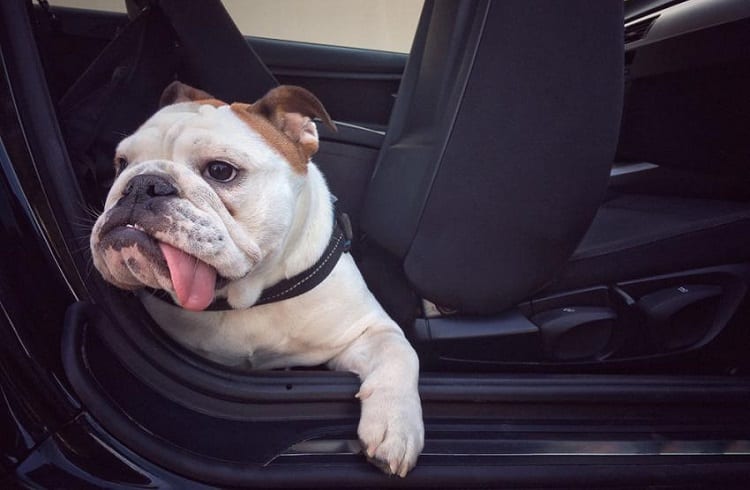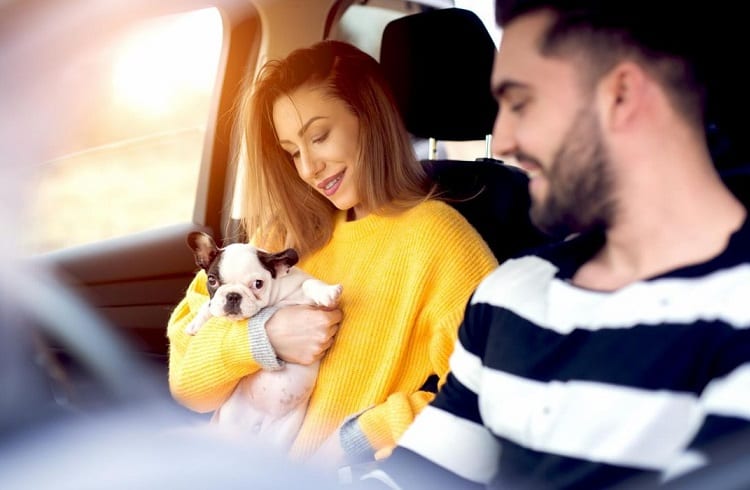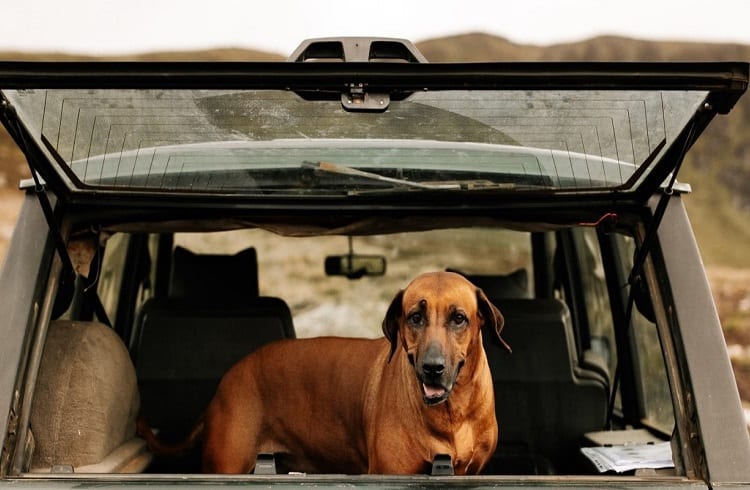This post may contain affiliate links. Please read my disclaimer policy
Most dogs love nothing more than getting loaded up into the car to go for a drive with their owners, but for some dogs, it’s not a pleasant experience at all.
Just as we humans can be affected by the nasty feelings of car sickness, so too can our dogs, and it means the once joyful car ride has become a time of anxiety and illness.
Dogs are capable of getting car sick just as we do, and although it usually happens to younger dogs and puppies, there are older dogs who experience it as well. It might not always present as car sickness does in humans but the experience will be unpleasant for them, so we want to do all we can to prevent it in the future.
Why do dogs get car sickness and how can we stop it?
Dogs get motion sickness when traveling in cars for the same reasons that humans do, but it can also be caused by anxiety and nervousness from driving. To prevent dog car sickness, you can slowly ease them into car trips, secure them with a harness so they feel protected, and know the signs to look out for that indicate they’re feeling unwell.
If your pooch is prone to sickness while driving or you have a younger dog that hasn’t yet mastered riding in the car, we’re here to help. We can explain why dogs get sick, how to tell when your dog might be feeling off in the car, and what you can do to ensure smooth sailing in the future whenever your pooch comes along for a drive.
Contents
Why Do Dogs Get Car Sick?

Motion sickness is a common occurrence in younger dogs, and sometimes in older dogs who haven’t outgrown it.
Just as some humans find they get sick when traveling in the car, so to do canines, and there are a few reasons why it might occur.
The most common cause is that the ear structures of young dogs are underdeveloped and they don’t fully allow for balance yet, which can be made more obvious when they’re driving in the car. Regardless of how you try to help them, they’ll still have this feeling until their ears develop and they outgrow the motion sickness, around one year of age.
Sitting backward, looking out the window, and the position they’re sitting or lying in while driving can all exasperate car sickness. Fortunately, most dogs learn to perfect these so they can make themselves comfortable as they grow older, but it’s not always this easy.
For other dogs who have grown past the ear imbalance age, the car can still be a great source of stress and worry. Whether this has come from their younger days of feeling sick when they’re in it or another traumatic experience, it can be hard to shake.
Sometimes dogs associate the car with trips to the vet, so they might assume that it only leads to bad things, rather than fun trips to the park or the beach.
How To Recognize Dog Car Sickness
When we’re feeling sick ourselves that are used to getting an upset stomach in the car, there are some obvious signs we can look for.
Someone might go pale and quiet, and let us know that they’re feeling off. For dogs, the signs can be a little different, so keep an eye out for the following that can indicate car sickness:
- Licking lips or smacking lips;
- Whining;
- Pacing or moving around the car;
- Drooling;
- Inactivity;
- Vomiting;
- Diarrhea;
If you notice any of these signs in your dog, pull over the car and let them out for a walk. Just a few minutes off the road can be enough to calm their stomachs and get them back in the car again.
Preventing Sickness in the Car

Car sickness in dogs usually happens with younger dogs, but it’s a condition that can remain even in older ones as well.
The best approach for preventing sickness is to condition your dog to get them used to riding in the car, which takes time but has the best long-lasting effect.
As many dogs experience this sickness because they’re feeling nervous in the car, it’s all about helping them overcome stress, and showing them that there’s nothing wrong with going for a drive. You’ll need to take several short trips at first so they understand the motions of what happens when they get in the car and it moves, and the fact that they always end up back home and safe.
The first time, you can place your dog in the car and turn it on, just sitting with them in the driveway. The next time, drive just a short distance down the road and then turn around to come back home. Once you make it home, reward them and offer positive reinforcement to let them know they did a good job.
The goal here is to work your way up to a longer trip of around 30 minutes. By this stage, they’ll have their own tools that can ease sickness in the car as well as the knowledge that it’s safe to be driving, and this gradual conditioning will set them up for longer journeys in the future.
Keeping Your Pooch Calm on Drives
A calm dog is a happy dog, and as you’re driving with them, everything you do is affecting how calm they are.
During this conditioning phase, while you’re taking them short distances, it’s all about exposing them gradually and making the journey a little bit more challenging each time without overwhelming them.
To keep them calm, you can talk to them or sing, so that they know you’re with them. This is especially helpful if you’re not within your dog’s line of sight in the car. If they show any signs of nervousness or that they might be sick, pull over immediately and give them a chance to calm down and feel better. You may even need to take them out for a short walk to get them to relax.
Some dogs might find it easier to ride in a dog carrier, as they feel more secure. If you plan on traveling long distances with your dog and want to use a carrier anyway, you’ll have to condition them to be comfortable with it regardless. Never scold your dog or tell them off for feeling scared, as this will only heighten their anxiety and make the process harder.
What to Give a Dog for Car Sickness

Unlike humans, it’s not as widely recommended to treat motion sickness with a pill that can help them feel better when they’re driving.
If the reason for your dog’s illness is because of anxiety and stress, it’s more about adjusting the environment and mood of the car ride to help them feel better about it.
For dogs that have been assessed by the vet as having motion sickness not caused by anxiety, they might be prescribed something like Dramamine, which is a human antihistamine. These have been shown to be helpful for treating motion sickness in dogs sometimes, but they come with other side effects like drowsiness and a dry mouth that can further trouble your pet.
Tips for Making Car Rides Better for Your Dog
Treating car sickness isn’t a one size fits all approach, so there might be some trial and error as you figure out what works for your dog. These are some tips you can try if your dog continues to feel sick when they’re driving with you in the car:
- Bring along a sweater or their dog bed so they have something that smells like home with them.
- Avoid giving your dog a large meal 12 hours before you go for a drive. Small treats are okay, but a big meal can make it harder for their stomach to settle in the car and may lead to accidents.
- Have the car’s interior at a comfortable temperature and don’t have any music playing. Talk to your dog if you think it’ll help calm them down.
- Use a dog harness or seatbelt that keeps them secure as you drive. Dogs find pressure around their chest calming, and a harness provides this as well as safety from sharp turns and sudden braking.
- Bring along a brand new toy to distract them in the car. Leave it in the car so they can only play with it there, ensuring they don’t get bored of it.
- Roll down the car windows a couple of inches on each window. This will help pressurize the air inside the car and can stop them from feeling uneasy.
- Try taking them for a ride in a different car. They might have associated feeling anxious and sick with your specific vehicle and just need a change of scenery to get used to it.
Related Questions

Taking your dog in the car should be a thing of joy, but that’s not always the case for every pooch.
Whether they’ve had a bad experience in the past or haven’t outgrown the queasy feeling they get from driving, it doesn’t mean you have to give up on the idea of car rides altogether. Check out the answers to these FAQs that might help you with your dog’s car sickness.
Do Dog Car Seats Help With Motion Sickness?
Sometimes a dog might feel sick in the car because they feel unsafe or not secure. Using a dedicated dog harness or dog car seat can keep them snug and in place, while also ensuring they are facing the right direction to prevent car sickness.
However, you’ll have to test them on your dog as some don’t like the feeling of being too secured, which can lead to further anxiety.
How Long Does Car Sickness Last in Dogs?
If your puppy is prone to getting motion sickness in the car, this should start to slow down by the time they turn one year old.
However, residual feelings of stress and anxiety can remain due to bad experiences in the car even as adult dogs, which requires further training and conditioning to help.

